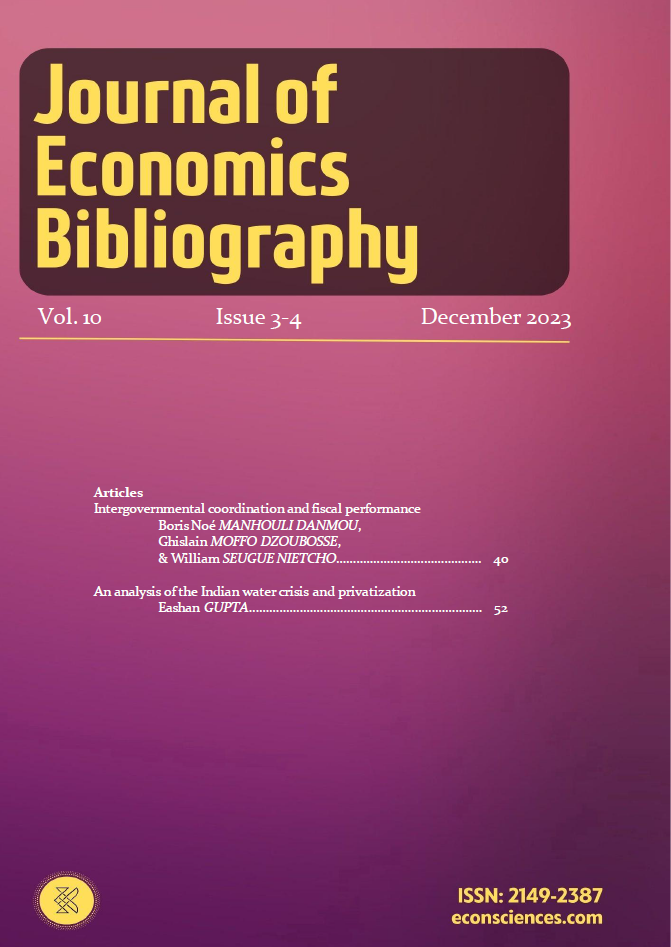Abstract
Abstract. In recent years, governance issues have been identified as critical to macroeconomic performance. This study aims to contribute to the debate on the role of governance in allocating public spending in general and specifically in education spending, focusing on a panel of the six CEMAC countries from 1997–2013. It thus examines the role of governance as measured by the level of corruption, political stability, government effectiveness, regulatory quality, and the level of voice and accountability in the allocation of public expenditure to education through a linear regression in static panel data. It emerges empirically that a low allocation of public spending on education can be largely explained by a poor quality of governance in CEMAC.
Keywords. Governance, Public spending, Education, Panel data, CEMAC.
JEL. E62; I28; H52; H11.
References
Agénor, P.R. (2012). Infrastructure, public education and growth with congestion costs. Bulletin of Economic Research, 64(4), 449-469. doi. 10.1111/j.1467-8586.2011.00395.x
Aliaga, A.O. (2001). Human capital, HRD and the knowledge organization. Aliaga AO (Eds.).
Asongu, S.A., & Odhiambo, N.M. (2020). The role of governance in quality education in sub‐Saharan Africa. International Social Science Journal, 70(237-238), 221-238. doi. 10.1111/issj.12253
Barro, R.J. (1991). Economic growth in a cross section of countries. The Quarterly Journal of Economics, 106(2), 407-443. 10.2307/2937943
Becker, G.S. (1962). Investment in human capital: A theoretical analysis. Journal of Political Economy, 70(5, Part 2), 9-49. doi. 10.1086/258724
Benhabib, J., & Spiegel, M.M. (1994). The role of human capital in economic development evidence from aggregate cross-country data. Journal of Monetary economics, 34(2), 143-173. doi. 10.1016/0304-3932(94)90047-7
Bhuiyan, S.H. (2011). Modernizing Bangladesh public administration through e-governance: Benefits and challenges. Government Information Quarterly, 28(1), 54-65. doi. 10.1016/j.giq.2010.04.006
Bourguignon, A. (1995). Peut-on définir la performance?/Can we define performance. Revue Française de Comptabilité.
Conaty, F.J. (2012). Performance management challenges in hybrid NPO/public sector settings: an Irish case. International Journal of Productivity and Performance Management, 61(3), 290-309. doi. 10.1108/17410401211205650
Delavallade, C. (2006). Corruption and distribution of public spending in developing countries. Journal of Economics and Finance, 30(2), 222-239. doi. 10.1007/BF02761488
Denison, E.F. (1962). Education, economic growth, and gaps in information. Journal of Political Economy, 70(5, Part 2), 124-128. doi. 10.1086/258729
Devarajan, S., Swaroop, V., & Zou, H.F. (1996). The composition of public expenditure and economic growth. Journal of Monetary Economics, 37(2), 313-344. doi. 10.1016/S0304-3932(96)90039-2
Engelbrecht, H.J. (2003). Human Capital and Economic Growth: Cross‐Section Evidence for OECD Countries. Economic Record, 79(SpecialIssue), S40-S51. doi. 10.1111/1475-4932.00090
Felts, A.A., & Jos, P.H. (2000). Time and space: The origins and implications of the new public management. Administrative Theory & Praxis, 22(3), 519-533.
Fouda B.J., Nzongang J., Manhouli B. & Djapou, C. (2022). La fiscalité locale: un levier du développement des CTD camerounaises sous le prisme de la dynamique PNDP. In Nga et Miamo, Décentralisation et développement local au Cameroun: une analyse de la contribution du PNDP, Chapitre 9, 253-274. Harmattan Paris.
Habibi, N. (1994). Budgetary policy and political liberty: a cross-sectional analysis. World Development, 22(4), 579-586. doi. 10.1016/0305-750X(94)90113-9
Hewitt, D.P. (1991). Military expenditure: econometric testing of economic and political influences. IMF Working Papers, 1991(053). doi. 10.5089/9781451847291.001
Hood, C. (1995). The “new public management” in the 1980s: Variations on a theme. Accounting, Organizations and Society, 20(2-3), 93-109. doi. 10.1016/0361-3682(93)E0001-W
Hyndman, N., & McDonnell, P. (2009). Governance and charities: An exploration of key themes and the development of a research agenda. Financial Accountability & Management, 25(1), 5-31. doi. 10.1111/j.1468-0408.2008.00463.x
Johnson, S., Kaufmann, D., McMillan, J., & Woodruff, C. (2000). Why do firms hide? Bribes and unofficial activity after communism. Journal of Public Economics, 76(3), 495-520. doi. 10.1016/S0047-2727(99)00094-8
Kallias, A., Kallias, K., Tsalkamas, I., & Zhang, S. (2023). One size does not fit all: The conditional role of CEO education on IPO performance. Journal of Business Research, 157, 113560. doi. 10.1016/j.jbusres.2022.113560
Kimenyi, M.S., & Mbaku, J.M. (1996). Rents, military elites, and political democracy. European Journal of Political Economy, 11(4), 699-708. doi. 10.1016/0176-2680(95)00029-1
Lucas Jr., R.E. (1988). On the mechanics of economic development. Journal of Monetary Economics, 22(1), 3-42. doi. 10.1016/0304-3932(88)90168-7
Mahdavi, S. (2004). Shifts in the composition of government spending in response to external debt burden. World Development, 32(7), 1139-1157. doi. 10.1016/j.worlddev.2004.01.011
Mauro, P. (1995). Corruption and growth. The Quarterly Journal of Economics, 110(3), 681-712. doi. 10.2307/2946696
Mihaiu, D.M., Opreana, A., & Cristescu, M.P. (2010). Efficiency, effectiveness and performance of the public sector. Romanian Journal of Economic Forecasting, 4(1), 132-147.
Nafukho, F.M., Hairston, N., & Brooks, K. (2004). Human capital theory: Implications for human resource development. Human Resource Development International, 7(4), 545-551. doi. 10.1080/1367886042000299843
Nyamongo, M., & Schoeman, N. (2010). The quality of governance and education spending in Africa. Southern African Business Review. 14, 1-23. doi. 10.1080/1367886042000299843
Pacific, Y.K.T. (2020). Fragility of State in Central African Republic: An Econometric Approach to Efficiency Understanding. Global Business Review, 21(3), 681-697. doi. 10.1177/0972150918779291
Rajkumar, A., & Swaroop, V. (2002), Public spending and outcomes: Does governance matter? World Bank Policy Research Working Paper, No.2840s. doi. 10.1016/j.jdeveco.2007.08.003
Rajkumar, A.S., & Swaroop, V. (2008). Public spending and outcomes: Does governance matter?. Journal of Development Economics, 86(1), 96-111. doi. 10.1016/j.jdeveco.2007.08.003
Reinikka, R., & Svensson, J. (2004). Local capture: evidence from a central government transfer program in Uganda. The Quarterly Journal of Economics, 119(2), 679-705. doi. 10.1162/0033553041382120
Schultz, T.W. (1961). Investment in human capital. The American Economic Review, 51(1), 1-17.
Shelton, C.A. (2007). The size and composition of government expenditure. Journal of Public Economics, 91(11-12), 2230-2260. doi. 10.1016/j.jpubeco.2007.01.003
Shoup, C.S. (1959). The theory of public finance. American Economic Review. 49(5), 1018-1029.
Stasavage, D. (2005). Democracy and education spending in Africa. American Journal of Political Science, 49(2), 343-358. doi. 10.1111/j.0092-5853.2005.00127.x
Stiglitz, J.E., Sen, A., & Fitoussi, J.P. (2009). Report by the commission on the measurement of economic performance and social progress. [Retrieved from].
Tabellini, G., & Alesina, A. (1988). Voting on the budget deficit. American Economic Review, 80(1), 37-49.
Uzun, B., & Celik-Simsek, N. (2018). Land readjustment for minimizing public expenditures on school lands: a case study of Turkey. Arabian Journal of Geosciences, 11, 1-12. doi. 10.1007/s12517-018-3586-3

This work is licensed under a Creative Commons Attribution-NonCommercial 4.0 International License.
